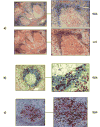Human innate B cells: a link between host defense and autoimmunity?
- PMID: 15633016
- PMCID: PMC1431976
- DOI: 10.1007/s00281-004-0188-9
Human innate B cells: a link between host defense and autoimmunity?
Abstract
B cells play a variety of immunoregulatory roles through their antigen-presentation ability and through cytokine and chemokine production. Innate immune activation of B cells may play a beneficial role through the generation of natural cross-reactive antibodies, by maintaining B cell memory and by exercising immunomodulatory functions that may provide protection against autoimmunity. In this article, we review human B cell populations and their functional properties, with a particular focus on a population of inherently autoreactive B cells, which seem to play an important physiological role in innate immunity, but which, if selected into adaptive immune responses, appear to become pathogenic agents in systemic lupus erythematosus.
Figures





References
-
- Martin F, Oliver AM, Kearney JF. Marginal zone and B1 B cells unite in the early response against T-independent blood-borne particulate antigens. Immunity. 2001;14:617. - PubMed
-
- Bernasconi NL, Traggiai E, Lanzavecchia A. Maintenance of serological memory by polyclonal activation of human memory B cells. Science. 2002;298:2199. - PubMed
-
- Chan O, Shlomchik MJ. A new role for B cells in systemic autoimmunity: B cells promote spontaneous T cell activation in MRL-lpr/lpr mice. J Immunol. 1998;160:51. - PubMed
-
- Harris DP, Haynes L, Sayles PC, et al. Reciprocal regulation of polarized cytokine production by effector B and T cells. Nat Immunol. 2000;1:475. - PubMed
-
- Yu P, Wang Y, Chin RK, et al. B cells control the migration of a subset of dendritic cells into B cell follicles via CXC chemokine ligand 13 in a lymphotoxin-dependent fashion. J Immunol. 2002;168:5117. - PubMed
Publication types
MeSH terms
Substances
Grants and funding
LinkOut - more resources
Full Text Sources
Other Literature Sources

